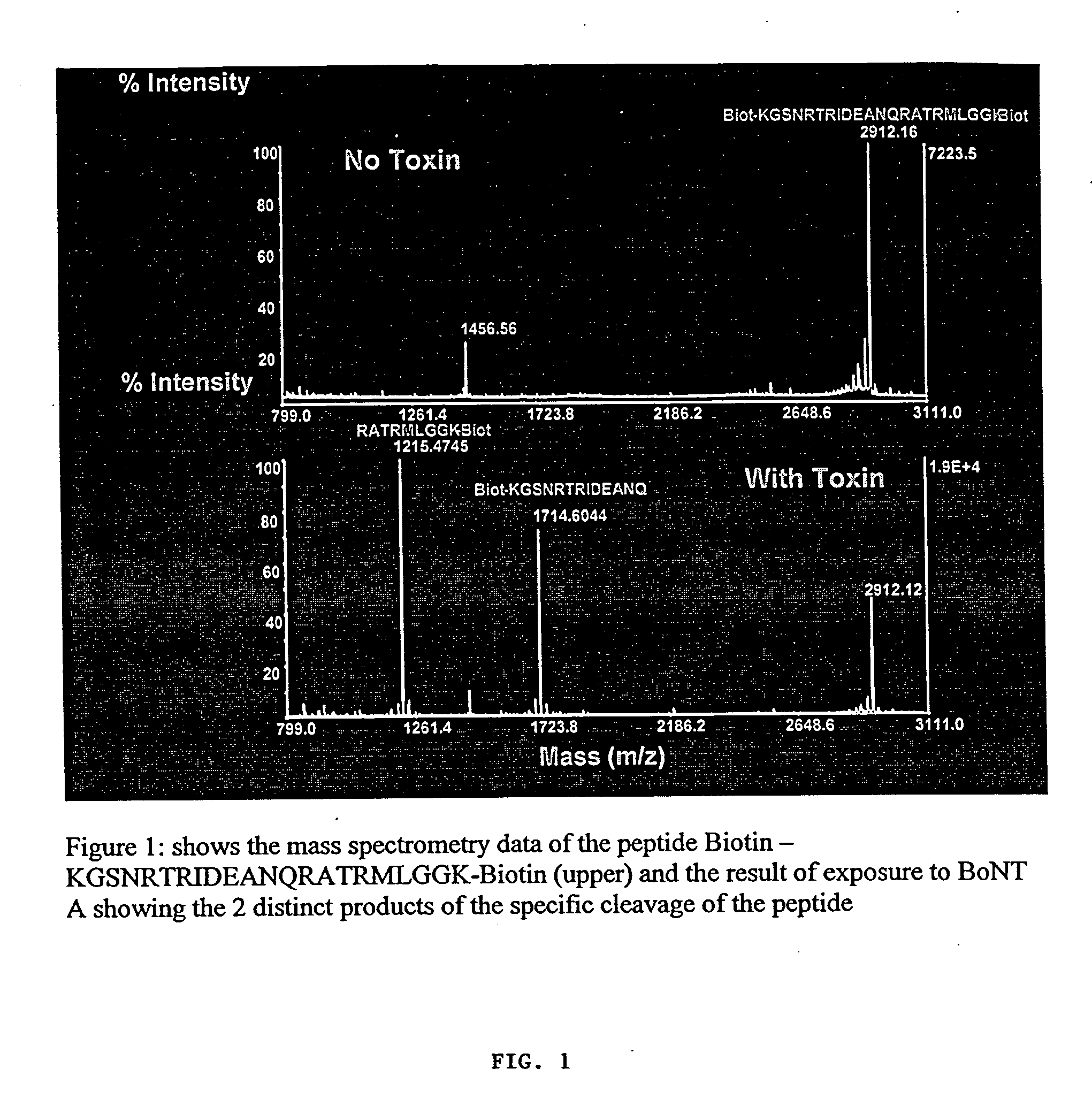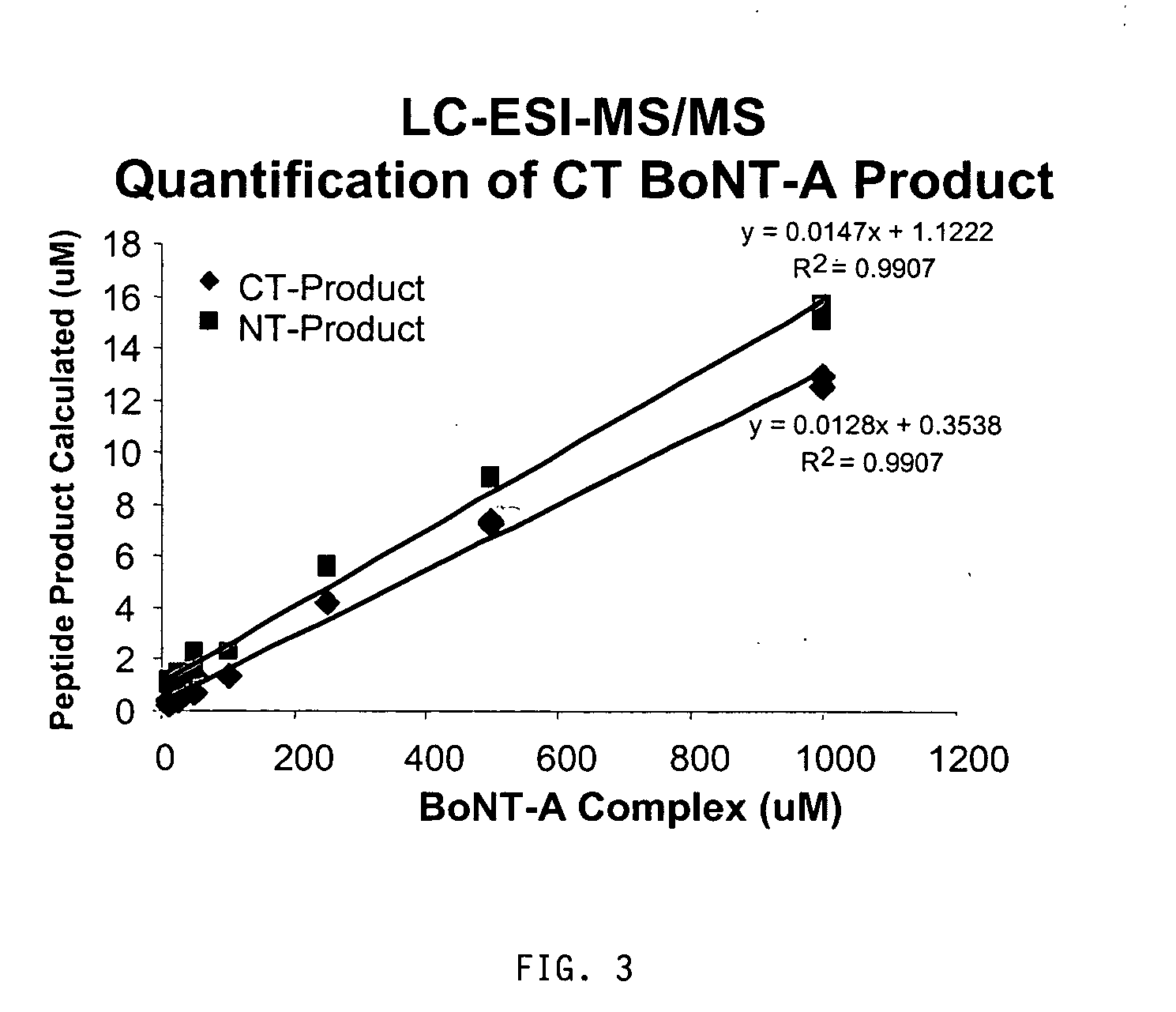Mass spectrometry-based methods for detection and differentiation of botulinum neurotoxins
a technology which is applied in the field of detection methods of botulinum neurotoxins and mass spectrometrybased methods for detection and differentiation of botulinum neurotoxins, can solve the problems of many animals being sacrificed, process takes nearly a week to complete, and the need for many animals to be sacrificed
- Summary
- Abstract
- Description
- Claims
- Application Information
AI Technical Summary
Benefits of technology
Problems solved by technology
Method used
Image
Examples
example 1
[0093] Peptidic substrates were obtained using standard solid state peptide synthesis. A C-terminal biotin was obtained using a commercial Lysine(K)-biotin resin (available from Advanced Chem. Tech.) and standard solid state peptide synthesis conducted to construct the desired substrate with the N-terminal biotin introduced onto the peptide on a Boc-lysine (Fmoc) terminus after deprotection of the sidechain using commercially available activated biotin succinimide (available from NovaBiochem). In this manner the peptidic substrate of Biotin-KGSNRTRIDEANQRATRMLGGK-biotin (Substrate 1) was prepared.
example 2
[0094] An initial sample of the peptide Biotin-KGSNRTRIDEANQRATRMLGGK-biotin (Substrate 1) was measured by MALDI-TOF-MS. The mass spectroscopy data of this sample is shown in FIG. 1(a).
[0095] The sample of the peptide Biotin-KGSNRTRIDEANQRATRMLGGK-biotin (Substrate 1) was then mixed with a sample of BoNT serotype A and the mixture was digested for two hours and the peptide substrate and products were specifically absorbed on avidin affinity columns, washed and then eluted with free biotin. The collected sample was then analyzed by MALDI-TOF-MS. The mass spectroscopy data of this sample is shown in FIG. 1(b). Two distinct peptide products were shown that were the result of the specific cleavage of the peptide. Excess biotin had a lower molecular weight outside the range of this MS range. Quantification of the amount of neurotoxin from the known quantities, time of digestion and MS data indicated detection of activity as low as 5 pc / mL of toxin.
example 3
[0096] As noted, the ENDOPEP-MS reaction has proven to be very useful for detecting small amounts of BoNT in a rapid, animal-free assay. The use of antibodies in concentrating the toxin can be conducted as follows. Antibodies can be obtained from a variety of sources, e.g., Metabiologics (Madison, Wis.) supplies antibodies in a solution of 150 mM potassium phosphate, pH 7.4. The concentration for each batch of antibody is different. Magnetic protein G beads can be obtained from Dynal (Lake Success, N.Y.) at 1.3 g / cm3 and are supplied in a solution of phosphate buffered saline (PBS), pH 7.4, containing 0.1% Tween®-20 and 0.02% sodium azide. Triethanolamine and dimethyl pimelimidate used for cross-linking can be obtained from Sigma-Aldrich (St. Louis, Mo.). Casein buffer is comprised of 5 g of casein (Sigma-Aldrich) dissolved in 500 mL of PBS (Sigma-Aldrich). PBS-T buffer is comprised of PBS with 0.005% Tween®-20 (Sigma-Aldrich). TBS buffer is comprised of Tris buffer saline (50 mM Tr...
PUM
 Login to View More
Login to View More Abstract
Description
Claims
Application Information
 Login to View More
Login to View More - R&D
- Intellectual Property
- Life Sciences
- Materials
- Tech Scout
- Unparalleled Data Quality
- Higher Quality Content
- 60% Fewer Hallucinations
Browse by: Latest US Patents, China's latest patents, Technical Efficacy Thesaurus, Application Domain, Technology Topic, Popular Technical Reports.
© 2025 PatSnap. All rights reserved.Legal|Privacy policy|Modern Slavery Act Transparency Statement|Sitemap|About US| Contact US: help@patsnap.com



